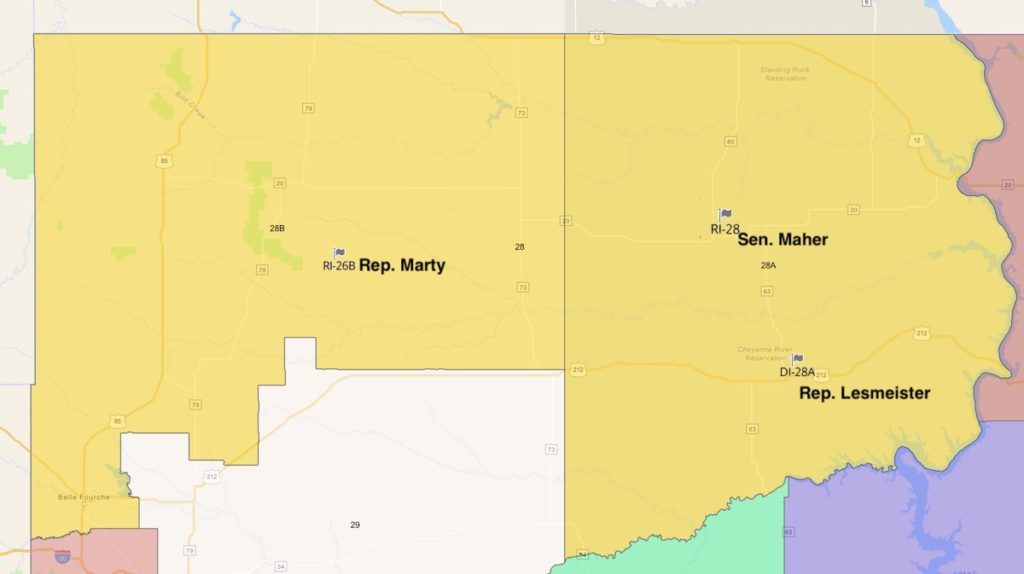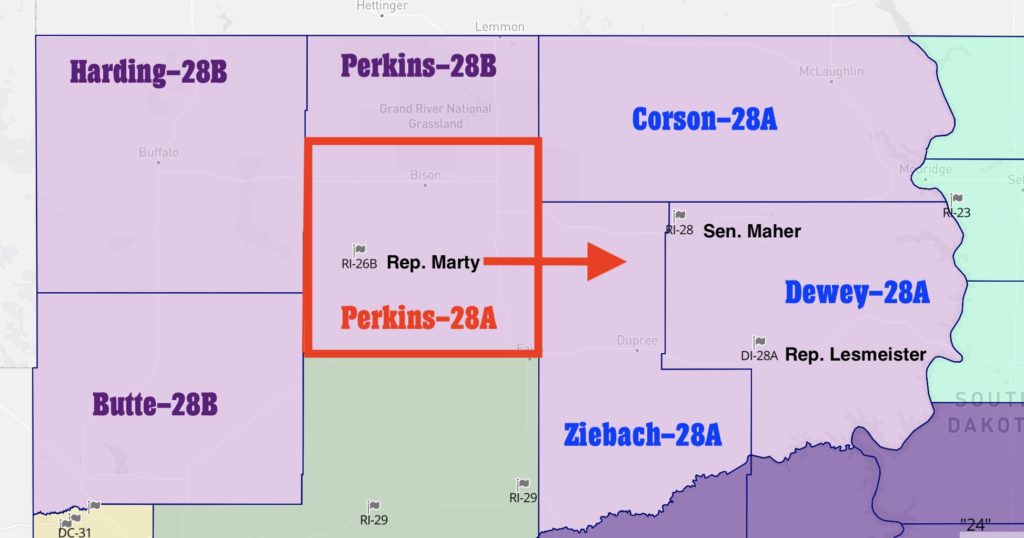Last updated on 2021-11-23
Hey, I think I see one big reason Representative Sam Marty (R-28B/Prairie City) voted against the new Sparrow redistricting map for 2022: the new lines yank him out of his single-member District 28B and put him in strongly Lakota and Democratic District 28A.
District 28 is one of two Legislative districts (the other is 26) that is divided into two single-member House districts to give our Lakota neighbors at least one district in which they have the majority of voters. While the entire district is represented by just one Senator, currently Ryan Maher (R-28/Isabel), the district elects one House member from its eastern half—28A: Corson, Dewey, and Ziebach counties, on the Standing Rock and Cheyenne River Sioux Reservations, where the voter population is over 70% Indian—and one House member from its western half—28B: Harding County, nearly all of Perkins County, and most of Butte County, where the voter population is over 90% white.

According to the 2020 Census, Corson, Dewey, Ziebach, and Perkins counties all lost population. Harding and Butte counties grew, but not enough to make up for the other four counties loss, let alone keep up with the 8.9% growth in the population of the entire state. To reach the increased district target population of 25,333, District 28 had to take in more turf. Legislators settled on the neat solution of drawing in the southern bits of Perkins and Butte that previously joined most of Meade County in District 29. (Meade County grew 17.4% over the past decade and thus could afford to give up territory.)
But the single-member districts still need to be balanced, close to the target population of 12,667, and the current dividing line at the eastern Perkins county line would leave too few people in 28A and too many people in 28B. The three reservation counties together Census up to 11,554, 8.8% below target, while the three western counties hold 14,389, 13.6% above target.
The Senate solved this problem (and a slim majority of House members acceded to this solution) in 2021r House Bill 1001 by adding to District 28A “The portion of Perkins County consisting of precincts VTD-precinct 6, VTD-precinct 7, VTD-precinct 8, VTD-precinct 9, VTD-precinct 12.” That’s the southern two thirds of Perkins County, including Meadow, Bison, and Prairie City on Highway 20:

Joining those five Perkins precincts with Ziebach, Corson, and Dewey raises 28A’s population to 12,687, 0.16% above target and keeps the Indian percentage of 28A’s voting population at 67.4%. Leaving Lemmon, Lodgepole, and most of the Grand River National Grassland joined to Harding and Butte puts 28B’s population at 13,256, 4.65% above target.
But 28B’s current Representative, Republican Sam Marty, lives on the rangeland south of Prairie City, in Precinct 7, by my Google maps reckoning near the confluence of the mighty Antelope and Dog creeks. I’m sure that’s fine country for grazing and meditating, but for poor white conservative Sam Marty, that’s now, Legislatively speaking, Indian country, District 28A.
Not that the good voters of District 28A are unwilling to vote for white folks. For the last ten years, Ziebach+Corson+Dewey have elected as their sole Representative white fellers with a proclivity for Western wear just like old Sam. But those white fellers, Dean Schrempp and now Oren Lesmeister, are Democrats, and Sam Marty is most definitely not.
Rep. Marty preferred the House Grouse map, which would have balanced 28’s single-member House districts by joining Lemmon and its surrounding Precinct 5 to 28A. That Grouse split would have kept Marty in District 28B. Grouse would have created more equal Census numbers—12,944 for 28A and 12,999 for 28B. But it also would have split Lemmon-y country voters who live west of the great Highway 12 ridge from their urban counterparts.
Of course, Rep. Marty doesn’t have much to grouse about. He’s in his fourth term in the House and thus can’t run for House again in 2022. He could run for Senate for the entire District 28, but incumbent Senator Ryan Maher (R-28/Isabel) is only in his third Senate term and might not appreciate a primary challenge.
If Rep. Marty wants to save his per diem, he thus needs to get Senator Maher to run for District 28A house against Rep. Lesmeister, who is in his third term. Maher used to be a Democrat, and he lives on reservation land along with Lesmeister, so he would have a better shot of unseating Lesmeister than Marty would if he weren’t termed out.
Meanwhile, the new Sparrow District 28B sits empty of an incumbent, and Marty faced no challengers in either the 2020 primary or general. 28B thus awaits any eager candidates from Belle Fourche, Buffalo, and Lemmon to take their shot at single-member stardom.
There must be some blue state refugee living in 28B to take their cause to Pierre.
You know, until there is true Democracy in America, there will be no true representation. Say California has to give Republicans the weight of their numbers, wouldn’t that be something? It transfers to South Dakota, what is the weight of Democrats, one third of the population? Are they represented at all? Until all party’s are represented, not just two, gosh one better than China, why bother?
Well…back in the day there were more than a few Democrats in what you call District 28B now. I once met an older gentleman named Matt Haffner who ran for Lt. Governor on the Democratic ticket in the 50’s and I believe he was from the Belle Fouche area. There had been a number of Finns settle in the irrigation district and they were oriented to the Democratic Party. I doubt that the Party has much strength today but there is something out there to build on.
That wouldn’t surprise me at all, Richard. Those blue state refugees clearly are ready to ignore Kristi Noem’s edict and change South Dakota… or maybe just restore our First Amendment rights.
Mark, you know that I agree that South Dakota needs more Democrats in office. But I wonder: are political parties entitled to representation? Think of all the adjectives that can describe and classify voters: which adjectives capture the most salient characteristics that deserve/demand proportionate representation?
Consider that SD’s registered electorate (which is only 65% of our total population) is 48% GOP, 27% Dem, and 24% ind. We could argue that means we should set some constitutional quota of 17 GOP Senators, 9 Dem Senators, and 9 indy Senators (the rounding is dicey, but that’s what happens with small numbers of elected officials).
But is representation of parties more important that representation of races, which would require 30 white Senators, 3 Lakota Senators, 1 Hispanic Senator, and 1 Senator drawn from a pool of other minorities? Or sex representation, which would give us 18 women and 17 men in the Senate? Would we need to assign one Senate seat to the transgender population? Maybe 30 straight cis-Senators and then one for each of the magic letters, LGBTQ?
What about representation by occupation? What people do for a living, whether they work in farming or banking or retail or construction, has a significant impact on their needs and desires with respect to public policy. Suppose we based representation on how many people work in certain industries (who, according to the 2020 Q4 Census Workforce Indicators I’m looking at, constitute only 41% of South Dakota’s population and do not take into account people who are full-time students or retired, who have their own political priorities), the Senate would need 6 health care and social workers, 4 manufacturing workers, 4 retail workers, 3 educators, 3 hotel and food service workers, 2 construction workers, 2 public administration workers, 2 workers from finance and insurance, 2 wholesale trade workers, and maybe one Senator each from arts careers, professional fields, other services, admin/support/waste management, and farming (imagine that: just one farmer in the whole Senate, fairly representing the actual proportion of farmers in South Dakota’s workforce) and then a couple more who would rotate in from all the sectors that by themselves would round down to less than one senator.
What qualifies subgroups for constitutionally mandated representation, for quotas that would prescribe or even override the free choice of the electorate expressed by majority vote? Right now all we use is population and geography, with a nod toward race in a couple of districts drawn to include majority Lakota voters. What sort of districts would we have to draw to encompass any other groupings?
Or could we abolish districts entirely and offer South Dakotans ballots with no names, only classifications in which voters mark what sort of person they want representing them: man or woman? gay or straight? white, Indian, or otherwise? Teacher, banker, farmer, student, retiree? Tally up those choices, then use those tallies to pick from a pool of registered candidates?
But then what if the people who register as candidates, who are willing and able to serve, don’t include enough women or enough Lakota or enough teachers to fill the electorate’s desired quota?